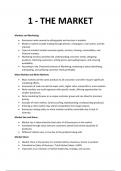1 - THE MARKET
Markets and Marketing:
• Businesses make money by selling goods and services in markets.
• Modern markets include trading through phones, newspapers, mail orders, and the
internet.
• Types of markets include consumer goods, services, housing, commodities, and
financial markets.
• Marketing involves activities like understanding consumer needs, designing
products, informing customers, setting prices, persuading buyers, and ensuring
availability.
• According to the Chartered Institute of Marketing, marketing is about identifying,
anticipating, and satisfying customer needs profitably.
Mass Markets and Niche Markets:
• Mass markets sell the same products to all consumers and often require significant
marketing efforts.
• Economies of scale can lead to lower costs, higher sales, and profits in mass markets.
• Niche markets are small segments with specific needs, offering opportunities for
smaller businesses.
• Niche marketing focuses on a unique customer group and can allow for premium
pricing.
• Example of niche market: Zumiez (surfing, skateboarding, snowboarding products).
• Entering a niche market may attract competition from larger players.
• Businesses relying solely on niche markets could be vulnerable due to lack of
diversity.
Market Size and Share:
• Market size is determined by total sales of all businesses in the market.
• Estimated through value (amount customers spend) and volume (quantity of
products).
• Different markets vary in size due to the products being sold.
Market Share:
• Market share is the portion of a market held by a business, brand, or product.
• Calculated as (Sales of Business / Total Market Sales) x 100%.
• Important as an indicator of market leadership, strategy, and success.





